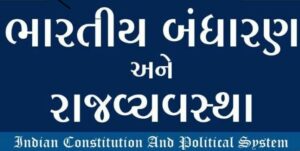Bharat Nu Bandharan PDF : India, also known as Bharat, is a Union of States. It is a Sovereign Socialist Secular Democratic Republic with a parliamentary system of government. Bharat Nu Bandharan PDF is very useful pdf for Gujarat level Competitive exams.
Bharat Nu Bandharan PDF
The Republic is governed in terms of the Constitution of India which was adopted by the Constituent Assembly on 26th November, 1949 and came into force on 26th January, 1950. he Constitution provides for a Parliamentary form of government which is federal in structure with certain unitary features. The constitutional head of the Executive of the Union is the President.
As per Article 79 of the Constitution of India, the council of the Parliament of the Union consists of the President and two Houses known as the Council of States (Rajya Sabha) and the House of the People (Lok Sabha). Article 74(1) of the Constitution provides that there shall be a Council of Ministers with the Prime Minister as its head to aid and advise the President, who shall exercise his/her functions in accordance to the advice. The real executive power is thus vested in the Council of Ministers with the Prime Minister as its head.
Bharat Nu Bandharan PDF
The Constitution of India came into force on 26th January, 1950. At the time of its adoption, the Constitution contained 395 Articles and 8 Schedules and was about 145,000 words long, making it the longest national Constitution to ever be adopted. Every Article in the Constitution was debated by the members of the Constituent Assembly, who sat for 11 sessions and 167 days to frame the Constitution, over a period of 2 years and 11 months.
This section contains every Article in the amended Constitution of India (as of 2020), with its corresponding Article in the Draft Constitution of India, 1948. Each Article also contains a summary of the debates on that Article in the Constituent Assembly. The Articles are grouped into 22 different parts, which reflects how they are organized in the text of the Constitution of India, 1950
Also Read : Bharat Nu Bandharan Online Test
The Schedules to the Constitution, which are now 12 in number, elaborate on government policy or rules in relation to specific Articles of the Constitution. Each Schedule in this section is tagged with the corresponding Article(s) for ease of understanding.

Bharat Nu Bandharan PDF
It imparts constitutional supremacy (not parliamentary supremacy, since it was created by a constituent assembly rather than Parliament) and was adopted by its people with a declaration in its preamble. Parliament cannot override the constitution. Dr. B. R. Ambedkar and Constitution of India on a 2015 postage stamp of India It was adopted by the Constituent Assembly of India on 26 November 1949 and became effective on 26 January 1950.
Also Read : Din Vishesh PDF March | Most Important GK Material 1 to 31st March
The constitution replaced the Government of India Act 1935 as the country’s fundamental governing document, and the Dominion of India became the Republic of India. To ensure constitutional autochthony, its framers repealed prior acts of the British parliament in Article 395. India celebrates its constitution on 26 January as Republic Day.
Bharat Nu Bandharan PDF
The constitution declares India a sovereign, socialist, secular, and democratic republic, assures its citizens justice, equality and liberty, and endeavours to promote fraternity.The original 1950 constitution is preserved in a helium-filled case at the Parliament House in New Delhi. The words “secular” and “socialist” were added to the preamble in 1976 during the Emergency.
The constitution was drawn from a number of sources. Mindful of India’s needs and conditions, its framers borrowed features of previous legislation such as the Government of India Act 1858, the Indian Councils Acts of 1861, 1892 and 1909, the Government of India Acts 1919 and 1935, and the Indian Independence Act 1947. The latter, which led to the creation of India and Pakistan, divided the former Constituent Assembly in two. Each new assembly had sovereign power to draft and enact a new constitution for the separate states.

